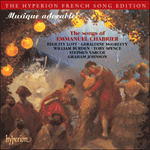
Welcome to Hyperion Records, an independent British classical label devoted to presenting high-quality recordings of music of all styles and from all periods from the twelfth century to the twenty-first.
Hyperion offers both CDs, and downloads in a number of formats. The site is also available in several languages.
Please use the dropdown buttons to set your preferred options, or use the checkbox to accept the defaults.

| Dame Felicity Lott (soprano), Graham Johnson (piano)» More |
It is true that an arrangement of this sort, where there is no orchestral colour and where the explosive effect of the music is tied to the human voice and its inability to blare like a trombone, is a less exciting affair than the original version. It is for this reason that Chabrier himself was careful to mark the autograph with the words ‘d’après la Rapsodie de E.C.’ – ‘after the Rhapsody of E. Chabrier’ – to separate the transcription from the original orchestral piece. The singer finds herself spitting out a slew of words which are far too clumsy to be original word-settings. So this music must be heard in the spirit in which it was intended. Even the ebullience of the piano writing (Chabrier broke Wagner’s piano in Wahnfried when he had the temerity to play this piece to Cosima Wagner in a solo arrangement) has to be thinned and toned down to give the singer a chance of being heard. Given that the voice has to negotiate a certain amount of orchestral writing (melismatic sextuplets which, at this tempo, are less than vocally idiomatic) the piece remains enormous fun. The accompanist somehow has to capture the force and spirit of the original while preserving the illusion that this is a real piece for voice and piano.
With a bit of luck, after a few pages one can forget the orchestral work and appreciate this arrangement for what it is – a riot of camp exaggeration long before ‘camp’ was officially defined, and before its enjoyment implied a sexual preference. It is clear from his letters from his Spanish visit that Chabrier was mesmerised by the lady dancers. He wrote: ‘The women are pretty, the men well built, and on the beach the señoras who have ample bosoms often forget to fasten their costumes. I’ll bring buttons, needle and thread to help them: to be of service is my only concern’; and later: ‘what an eyeful we are getting of Andalusian behinds wiggling like frolicsome snakes’. One can wonder at the composer’s genius for finding and manipulating Spanish rhythms and melodies (some of them assiduously transcribed during this sojourn) which sound more Spanish than the Spanish. This piece of music (at least in its original version) is one of the high-water marks of the dazzling ability of French composers (Lalo, Debussy and Ravel are others) to evoke the musical manners of Spain without musicological accuracy, and without compromising one iota of their own personalities. The French adored the work and the Spanish hated it. As Poulenc put it, the wrought-iron grilles of España come straight out of a big French department store. Such a remark from that inveterate Parisian was meant as a compliment to his beloved Chabrier.
from notes by Graham Johnson © 2002
 Chabrier: Songs Chabrier: Songs‘[A] real treasure of a treasury’ (BBC Music Magazine) ‘I cannot begin to tell you what delights await you on these discs … irresistible gems of melody, wit and tenderness. The enterprise has clearly ...» More |

